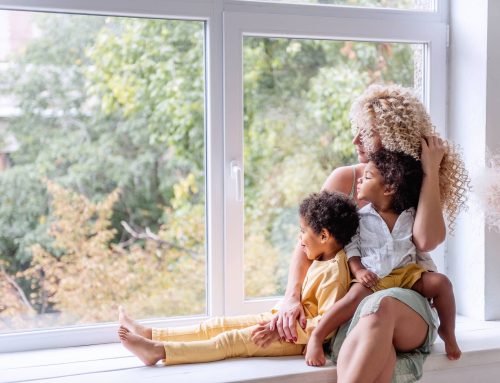Window replacement is a vital consideration whether you are remodeling an existing room or building a home extension. You have to account for the types and sizes of windows in a space because it can completely change the look and feel of both the room and the exterior of your home. However, while deciding between different types of windows and window designs, look and style should only play a part in your considerations. It is key to evaluate their energy efficiency, ventilation, and safety features, since they can all influence whether a window replacement design is appropriate for your home.
1. Casement windows
Casement windows, sometimes known as crank windows because of the manner used to open them, swing from a hinge, much like a door. Due to the excellent seal around these windows, they are often weathertight. When needed, the swing function also provides for a large volume of airflow. Screens may fit firmly inside the window, which is useful for cleaning.
With casement windows you will need to keep in mind the design of your home to ensure all these windows do not collide with anything in the exterior of your home like other nearby casement windows, a tree, or your neighbors home. Since they open outwards their window design should be considered when installing these windows in your home. In addition, casement windows are not suitable for securing window air conditioning systems, so use caution if you rely on this way of cooling.
The added benefits of casement windows is they are easy to open and close, they offer a weathertight, energy efficient seal, and they promote great airflow. Casement windows are usually installed above doorways, in stairwells, and in other hard to reach areas in the home where you want natural light to come in. Since the crank mechanism is relatively easy to operate with one hand, even when the user’s arm is fully extended to reach the crank, casement windows are ideal for those touch to reach areas in your home.
2. Single or double hung windows
Double-hung or single-hung windows glide along a vertical track to open and close. Although these two types of windows appear to be almost identical, the difference is that single-hung windows only open from the bottom half and double-hung windows can open from both the bottom and top halves . You do not have to worry about double- or single-hung windows colliding with one other or anything on the exterior or the house, unlike casement windows that swing outward.
These traditional windows offer decent ventilation, cleaning access, and are easier to replace than more unique window types. Since they operate against gravity, double- and single-hung windows may require more maintenance to ensure they keep operating as intended.
The added benefit of single or double hung windows is that they offer great ventilation, a number of retail offerings and can be cost-effective. Since this window type offers great ventilation they would be ideal to be installed in bathrooms and bedrooms. Homeowners with kids or pets can also keep the lower panel locked while allowing air in through the top panel for an added safety measure for those in your home.
3. Sliding windows
Sliding windows, a more typical alternative for horizontal window orientations, function just as they are called with one panel sliding over another, much like sliding glass doors. This can result in a lot of airflow and rather effective sealing. Sliding windows are commonly utilized for basement egress windows or backyard patios, but they may lack the elegant aesthetic required for situations where curb appeal is more important. Other than a lock, sliding windows lack mechanical components, which reduces maintenance and total costs.
Sliding windows are a great option to act as an egress window for areas in your home where you would want to enter or exit while still letting in an abundant amount of natural light. Sliding windows are accessible and easy to operate and depending on the materials used they can be very durable and long lasting.
4. Awning windows
This window type is derived from the awning-like protection they give when opened. As a result, they are fantastic choices if you want to keep your windows open during rain. Awning windows are usually paired above, below, or to the side of a picture window and have hinges at the top. Awning windows open from the top of the frame, as opposed to casement windows, which open along a vertical plane. When not in use, the crank mechanism provides a tight seal and is accessible and easy to use. Awning windows also provide for enough ventilation while open.
Since awning windows protrude outwards placement of this window type is important to consider because it may block pathways or collide with exterior objects. However, this issue can be avoided if awning windows are installed on the second storey of your home or on the first storey but higher up on the wall. Similar to casement windows, awning windows operate with a crank mechanism that is easy to use, even when reaching above your head. In result, awning windows can be used above doorways, in stairwells, and in narrow spaces that may be hard to access but need some natural lighting.
5. Bay windows
Bay windows refers to windows that are clustered together to protrude from the home and are both functional and visually appealing. This may be used to construct a bay or shelf on the interior. Individual windows in a bay window group intersect at right angles. Bow windows are similar to casement windows, however the shape is curved with no angles between the windows. The central window in a conventional bay window configuration is usually a fixed picture window, while the two surrounding windows might be casement, single- or double-hung windows.
Bay windows have added benefits like allowing a lot of natural light into your home. They also add some square footage inside your home due to its protruding design. Lastly they can add a contrasting look to the exterior of your home that can add to the aesthetic and curb appeal of your home’s outer features.
6. Bow windows
These big curving windows, which are made up of four or more linked windows, enhance the interior area of your home and give a panoramic perspective. They make a beautiful room centerpiece and have a lot of curb appeal. Bow windows provide additional shelf space for growing plants, exhibiting ornamental things, or providing more seats. Installing large windows involves extensive structural work, including headers and roof coverings. Bow windows tend to be installed on the curved structure of a home and provide impressive views of the yard and the neighborhood. Bow windows also allow for more natural light to enter your home.
Window replacement designs vary and each design has their own benefits. With the mentioned types of house windows hopefully it has assisted you in determining which alternatives may be ideal for your home renovation project. Windows are one of the most significant components of your home, and they require the highest care and attention when choosing, maintaining, and replacing them.






